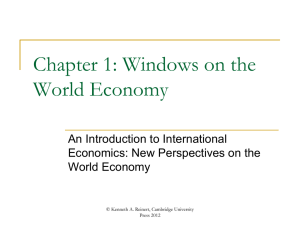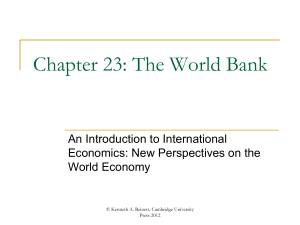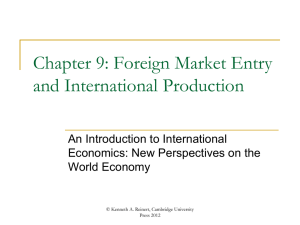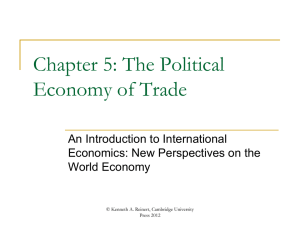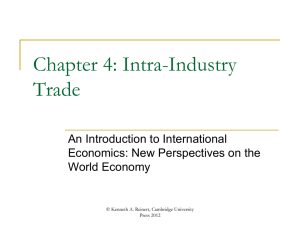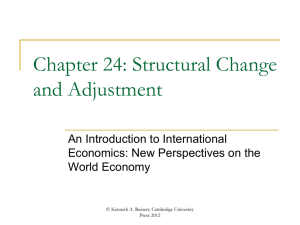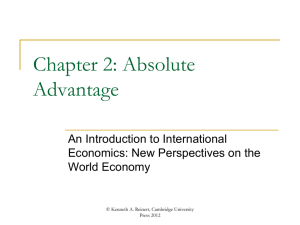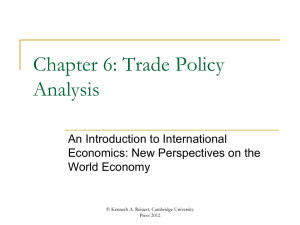Chapter 18 - An Introduction to International Economics
advertisement
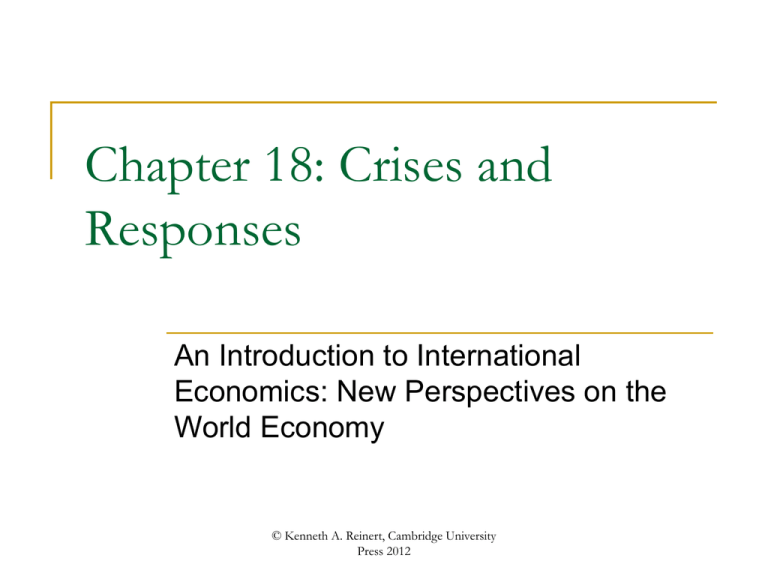
Chapter 18: Crises and Responses An Introduction to International Economics: New Perspectives on the World Economy © Kenneth A. Reinert, Cambridge University Press 2012 Analytical Elements Countries Currencies Financial assets © Kenneth A. Reinert, Cambridge University Press 2012 Types of Crises In order to get beyond popular descriptions of crises, we need to understand the different types of crises Six types of crises are listed in Table 18.1 Hyperinflation Balance of payments and currency crises Asset price deflation Banking crises External debt crises Domestic debt crises These can occur one at a time or in combinations © Kenneth A. Reinert, Cambridge University Press 2012 Table 18.1: Types of Crises Crisis Type Characteristics Hyperinflation A rapid increase in the overall price level of a country Balance and payments and currency crises A large devaluation or rapid depreciation in the value of a domestic currency in response to balance of payments difficulties Asset price deflation A sustained and large decline in the prices of financial assets Banking crises Bank runs and/or the merger, closure, or government closure of banking institutions External debt crises Sovereign debt default on obligations to foreign creditors or substantial restructuring of this debt Domestic debt crises Sovereign default on obligations to domestic creditors or substantial restructuring of this debt Sources: Eichengreen (1999) and Reinhart and Rogoff (2009) © Kenneth A. Reinert, Cambridge University Press 2012 Hyperinflation Hyperinflation is a period of rapid increases in the price level of a country, typically defined to be 40 percent or more Generally speaking, periods of hyperinflation are associated with rapid expansions of the money supply The case of Zimbabwe is presented in Figure 18.1 © Kenneth A. Reinert, Cambridge University Press 2012 Figure 18.1: Inflation in Zimbabwe © Kenneth A. Reinert, Cambridge University Press 2012 Balance of Payments and Currency Crises Balance of payments and currency crises consist of large devaluations or rapid depreciation in the value of domestic currencies Periods of hyperinflation can contribute to currency crashes Significant degrees of inflation can cause asset owners to move out domestic-currency-denominated assets in to foreign-currency-denominated assets to maintain portfolio values This causes a decrease in the demand for the domestic currency, lowering its value © Kenneth A. Reinert, Cambridge University Press 2012 Asset Price Deflation Asset price deflation involves a large and sustained decline in the prices of financial assets This typically follows behind large increases in asset prices or asset price bubbles The world economy is recovering from an asset price bubble that occurred up through 2007 A previous example of an asset price bubble in Japan is presented in Figure 18.2 © Kenneth A. Reinert, Cambridge University Press 2012 Figure 18.2: Asset Prices in Japan Source: Noguchi (1994) © Kenneth A. Reinert, Cambridge University Press 2012 Banking Crises Banking crises involve the occurrence of bank runs, mergers, closures,, or government takeovers of banking institutions In general, banking sectors are particularly fragile components of financial systems This reflects their involvement in maturity transformation Maturity transformation involves banks borrowing short term and lending long term Bank runs can be set off by asset price deflation, capital inflows surges and financial sector liberalization © Kenneth A. Reinert, Cambridge University Press 2012 External Debt Crises External debt crises involve sovereign default on debt obligations to foreign creditors or the substantial restructuring of this debt. The classic case of this is Mexico’s defaulting in 1982 on its foreign debt, setting of a global debt crisis Debt crises tend to follow large capital inflows © Kenneth A. Reinert, Cambridge University Press 2012 Domestic Debt Crises Domestic debt crises involve sovereign default on debt obligations to domestic creditors or substantial restructuring of this debt Reinhart and Rogoff (2009) emphasize that these events are understudied As with banking crises and external debt crises, preceding capital inflows are often a contributing factor Argentina in 2001 combined a banking crises, a currency crisis, both external and domestic debt crises, and asset price deflation © Kenneth A. Reinert, Cambridge University Press 2012 Contagion and Systemic Risk Contagion refers to crises beginning in one country and “spreading” to other countries This can occur through a few different mechanisms Shifts in expectations and confidence (herding or informational cascades) Asset prices (financial linkage) Capital flight (sudden stops) Sudden stops, surprise financial announcements and highly leveraged financial institutions can work together to cause contagion © Kenneth A. Reinert, Cambridge University Press 2012 Contagion and Systemic Risk When contagion takes on global or near-global characteristics, it becomes what is known as systemic risk These episodes are rare but characterized the Great Depression of the 1930s and the 2007-2009 crisis It is becoming clear that increased financial globalization has increased the possibility of systemic risk This is indicated by the volume of a number of key financial markets being multiples of global GDP © Kenneth A. Reinert, Cambridge University Press 2012 Analyzing Balance of Payments and Currency Crises “Old fashioned” balance of payments and currency crises have their roots in over-valued, fixed exchange rates and large current-account deficits Suppose that Mexico is successful in implementing an equilibrium exchange rate at e0 (Figure 18.3) Requires that the expected future exchange rate must equal the equilibrium rate ee = e0 In turn, requires that the interest rate on the peso must equal the interest rate on the dollar rM = rUS © Kenneth A. Reinert, Cambridge University Press 2012 Figure 18.3:A Balance of Payments and Currency Crisis © Kenneth A. Reinert, Cambridge University Press 2012 Analyzing Balance of Payments and Currency Crises Suppose that we find Mexico in a position of a current account deficit Current account deficit is always financed by a capital account surplus When a large trade deficit is financed by an inflow of short-term capital problems will soon develop The denomination in dollars exacerbates the problem because any fall in the value of the home currency inflates the domestic currency value of the debt Many domestic investors were aware of these problems and began to sell pesos during 1994 © Kenneth A. Reinert, Cambridge University Press 2012 Analyzing Balance of Payments and Currency Crises If you as Mexican investor feels that the Mexican government will have to devalue the peso in order to suppress the trade deficit, then you think that ee > e0 If rM = rUS and ee > e0 then rM Expected totalreturn on peso -denominated assets e e rUS e e Expected totalreturn on dollar-denominated assets You will buy dollars and sell pesos, participating in capital flight © Kenneth A. Reinert, Cambridge University Press 2012 Analyzing Balance of Payments and Currency Crises In response to such changes, in December 1994, the Mexican government devalued the peso by 15 percent This proved to be too little and fueled speculation of further devaluations The demand for pesos graph in Figure 18.3 shifted further to the left Mexico was forced to let the peso float Further and sudden shifts out of peso-denominated assets sent the peso into a deep fall © Kenneth A. Reinert, Cambridge University Press 2012 Figure 18.4: Balance of Payments and Currency Crises Revisited © Kenneth A. Reinert, Cambridge University Press 2012 “High-Tech” Crises “High-tech” crises typically include some elements of the balance of payments crises but also include some less-concrete factors that are often difficult to predict Combine current account deficits with weak financial sectors (especially in the banking system) and/or inappropriate capital account liberalization This view of crises is summarized in Figure 18.5 and characterized the Asian crisis of 1997 This crisis began in Thailand but spread through contagion effects to Malaysia, Indonesia, the Philippines, Hong Kong, South Korea, and Taiwan © Kenneth A. Reinert, Cambridge University Press 2012 Figure 18.5: A “High-Tech” Balance of Payments Crisis © Kenneth A. Reinert, Cambridge University Press 2012 The Asian Crisis The Asian crisis of 1997 involved the large devaluations featured in Figure 18.6 The high-tech features of the Asian crisis included Exposures of financial firms (including banks) to real estate and equity markets Capital account liberalization Poor regulation of banks The absence of hedging (see Chapter 14) The loss of confidence in the financial sectors of the Asian countries involved was a main culprit in the crisis © Kenneth A. Reinert, Cambridge University Press 2012 Figure 18.6: Nominal Exchange Rates of Four Asian Countries (1995=100) © Kenneth A. Reinert, Cambridge University Press 2012 The IMF Response The IMF’s response to the 1997 Asian crisis and the 1999 Brazilian crisis became a point of serious contention and debate IMF’s response can be characterized with three elements Interest rate increases Fiscal austerity Structural reforms Some observers suggested that these policies had been blindly transferred from IMF programs in Latin America to Asia © Kenneth A. Reinert, Cambridge University Press 2012 The IMF Response Interest rate increases tended to suppress domestic demand and sometimes fed into a sense of panic Fiscal austerity measures ignored the fact that the Asian crisis was not the result of profligate governments but profligate private sectors Structural reform requirements had two weaknesses They were overly broad They encroached on the traditional realm of the World Bank The specifics of this economic history are still being debated © Kenneth A. Reinert, Cambridge University Press 2012 The IMF Response: Indonesia The IMF response in the case of Indonesia was particularly controversial Particularly controversial was the IMF’s closing of 16 insolvent Indonesian banks All the more so given a picture that hit the Asian press which was interpreted through a neo-colonial lens (next slide) Critics alleged that this fed into panic and made matters worse Whatever the case, continued rioting in 1998 finally led to the 32 year reign of President Suharto © Kenneth A. Reinert, Cambridge University Press 2012 Camdessus Supervising Suharto: Neo-Colonialism? © Kenneth A. Reinert, Cambridge University Press 2012 The 2007 to 2009 Crisis Financial crises can and do occur in developed or high-income countries Causes include Capital inflows Financial liberalization Asset price inflation Overborrowing The sub-prime crisis emerged in the United States in 2007 to 2008 This involved sub-prime mortgages that had been bundled into mortgage-backed securities (MBS) © Kenneth A. Reinert, Cambridge University Press 2012 The 2007 to 2009 Crisis Losses in US housing markets were transmitted around the globe via a pyramid of financial instruments, include MBS Thereby, a crisis originating in one country took on a global profile through systemic risk described above Addressing this crisis had profound fiscal impact for the United States that have not yet been adequately addressed It also sparked a crisis in Europe discussed in Chapter 19 © Kenneth A. Reinert, Cambridge University Press 2012 Basel Standards The Basel Committee on Banking Supervision was established in 1974 In 1988, the Basel Committee introduced a banking capital measurement standard known as the Basel Capital Accord and later Basel I (see Table 18.2) In 1999, the Basel Committee began to develop a revision of Basel I that became Basel II based on three pillars Minimum capital requirements Supervisory review Disclosure for market discipline © Kenneth A. Reinert, Cambridge University Press 2012 Table 18.2: The Basel Accords Stage Years of approval/ implementation Components Basel I 1988/1992 Proposed regulatory capital requirements of eight percent. Basel II 2004/2007 Introduced three pillars of bank regulation (minimum capital requirements, supervisory review, and disclosure for market discipline) and two tiers of capital. Effectively reduced the capital requirement and allowed asset measurements to be risk adjusted by banks’ internal models. Basel III 2010/2012-2018 Improved asset risk adjustment and increased capital requirements to seven percent. © Kenneth A. Reinert, Cambridge University Press 2012 Basel Standards As the 2007-2009 crisis testified, Basel II was an utter failure Its conditions were simply too lax In response, Basel III was announced in 2010 Basel III tightens up the Basel II standards, for example, by tightening standards on Tier I and Tier II and increasing capital requirements from 2 to 7 percent Some observers think that even 7 percent is too lax © Kenneth A. Reinert, Cambridge University Press 2012 Capital Controls During the Asian crisis in 1997, the IMF considered adopting the full convertibility of capital accounts as a goal to be enshrined in a new Article of Agreement International economics became severely divided over the wisdom of this proposal We need to consider two points There are many different potential kinds of capital controls Capital controls can be tailored to different components of the capital account In 2010, the IMF staff acknowledged in an important paper the potential wisdom of market-friendly capital controls © Kenneth A. Reinert, Cambridge University Press 2012 Exchange Rate Target Zones Some international economists propose to combine the benefits of both fixed and floating exchange rate arrangements through use of exchange rate target zones In particular, John Williamson’s plan suggests the center of the target zone to be a fundamental equilibrium exchange rate (FEER) We can consider the FEER to be the purchasing power parity (PPP) rate defined in Chapter 14 See Figure 18.7 © Kenneth A. Reinert, Cambridge University Press 2012 Figure 18.7: An Exchange Rate Target Zone © Kenneth A. Reinert, Cambridge University Press 2012 Exchange Rate Target Zones Nominal exchange rate need not equal the real exchange rate and, therefore, the FEER Williamson terms “misalignments” situations in which e ≠ re = FEER Around the FEER, Williamson advocates the use of a broad exchange rate band, on the order of 10 percent Over time, the central FEER can be adjusted as economic situations change © Kenneth A. Reinert, Cambridge University Press 2012
